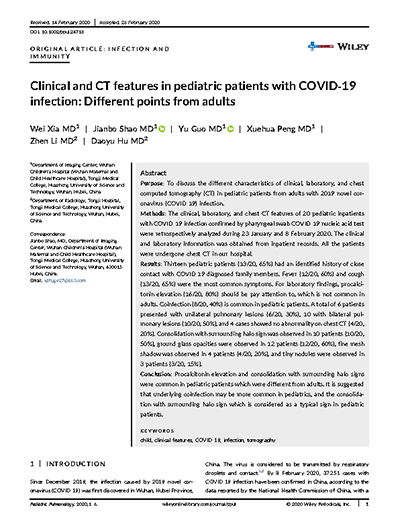26 Feb Clinical and CT features in pediatric patients with COVID-19 infection: Different points from adults
Wei Xia MD, Jianbo Shao MD, Yu Guo MD, Xuehua Peng MD, Zhen Li MD, Daoyu Hu MD
ABSTRACT
Objective: To discuss the different clinical, laboratory, and computed tomography (CT) features in pediatric and adult patients with 2019 novel coronavirus infection (COVID-19).
Methods: Clinical, laboratory, and chest CT characteristics of 20 hospitalized pediatric patients with COVID-19 infection, confirmed by throat swab COVID-19 nucleic acid test, who were retrospectively analyzed during January 23 and February 8, 2020.
Clinical and laboratory information was obtained from hospitalized patient records. All patients underwent chest CT at our hospital.
Results:
- Thirteen pediatric patients (13/20, 65%) had an identified history of close contact with family members diagnosed with COVID‐19.
- Fever (12/20, 60%) and cough (13/20, 65%) were the most common symptoms.
- Lab results:
- Attention should be paid to the procalcitonin elevation (16/20, 80%), which is not common in adults.
- Coinfection (8/20, 40%) is common in pediatric patients.
- A total of 6 patients presented unilateral lung lesions (6/20, 30%), 10 presented bilateral lung lesions (10/20, 50%), and 4 cases showed no abnormality on chest CT (4/20,20%). .
- Consolidation with the surrounding halo sign was observed in 10 patients (10/20, 50%).
- Ground glass opacities were observed in 12 patients (12/20, 60%).
- Shadow was observed in 4 patients (4/20, 20%).
- Small nodules were observed in 3 patients (3/20, 15%).
Conclusion: Procalcitonin elevation and consolidation with surrounding halo signs were common in pediatric patients, which were different from adults. It is suggested that the underlying coinfection may be more common in pediatrics and consolidation with a surrounding halo sign is considered a typical sign in pediatric patients.



